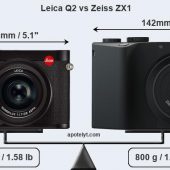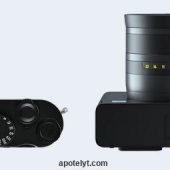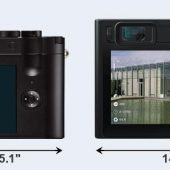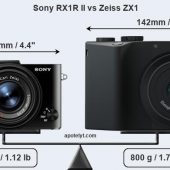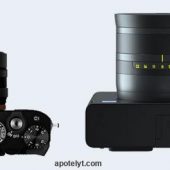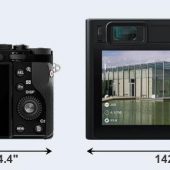
The original Leica Q is one of my favorite fixed lens camera’s of all time and I am sure the Leica Q2 will continue to be one of Leica’s best cameras. Also, the original Leica Q is discounted at this time so you might want to consider it over the new Leica Q2, but the Zeiss ZX1 is a different kind of camera. I am actually drawn to giving it a try over the Q2 because of it’s all in one approach. I think the Zeiss ZX1 or Leica Q2 will be the best-fixed lens full frame camera of 2019, but we will have to see when they launch.
Zeiss ZX1 (Coming Soon): B&H Photo / Amazon / Adorama
Leica Q2 Preorders: B&H Photo / Amazon / Adorama
Leica Q Typ 116: B&H Photo / Adorama / Amazon
In addition to Apotelyt’s photo comparisons above, they also have a list of reasons to prefer one over the other camera. If you want to read the full comparisons or want to make a new one check out Apotelyt.
Reasons to prefer the Leica Q2:
- More detail: Offers more megapixels (46.7 vs 37.4MP) with a 12% higher linear resolution.
- Maximized detail: Lacks an anti-alias filter to exploit the sensor’s full resolution potential.
- Larger viewfinder image: Features a viewfinder with a higher magnification (0.76x vs 0.74x).
- Faster shutter: Has higher mechanical shutter speed (2000/sec vs 1000/sec) to freeze action.
- Faster burst: Shoots at higher frequency (20 vs 3 flaps/sec) to capture the decisive moment.
- Better light gathering: Has a lens with a wider maximum aperture (f/1.7 vs f/2.8).
- Wider view: Has a wider-angle lens that facilitates landscape or interior shots.
- More compact: Is smaller (130x80mm vs 142x93mm) and thus needs less room in the bag.
- Less heavy: Is lighter (by 82g or 10 percent) and hence easier to carry around.
- Better sealing: Is weather sealed to enable shooting in dusty or wet environments.
- Sharper images: Has hand-shake reducing image stabilization built-in.
Advantages of the Zeiss ZX1:
- Better moiré control: Has an anti-alias filter to avoid artificial patterns to appear in images.
- More detailed viewfinder: Has higher resolution electronic viewfinder (6221k vs 3680k dots).
- Larger screen: Has a bigger rear LCD (4.3″ vs 3.0″) for image review and settings control.
- More detailed LCD: Has a higher resolution rear screen (2765k vs 1040k dots).
- Easier device pairing: Supports NFC for fast wireless image transfer over short distances.
- More affordable: Was released into a lower priced segment (16 percent cheaper at launch).

The Sony Cyber-shot DSC-RX1R II is a great fixed lens camera that has been around for a while now. Much like the Q it has a following, but its poor battery life has always been an issue. I owned the original RX1 and Q at the same time and for me, the Q was a superior camera and experience, but maybe Sony will update it again soon with the ZX1 and Q2 coming. The RX1RII has a few features that the Q and ZX1 are missing, but I think the ZX1 is still my preferred camera out of them all.
Zeiss ZX1 (Coming Soon): B&H Photo / Amazon / Adorama
Sony RX1II: B&H Photo / Amazon / Adorama
In addition to Apotelyt’s photo comparisons above, they also have a list of reasons to prefer one over the other camera. If you want to read the full comparisons or want to make a new one check out Apotelyt.
Arguments in favor of the Sony Cyber-shot DSC-RX1R II:
- More detail: Offers more megapixels (42.2 vs 37.4MP) with a 6% higher linear resolution.
- Maximized detail: Lacks an anti-alias filter to exploit the sensor’s full resolution potential.
- Better sound: Can connect to an external microphone for higher quality sound recording.
- More flexible LCD: Has a tilting screen for odd-angle shots in landscape orientation.
- Faster shutter: Has higher mechanical shutter speed (4000/sec vs 1000/sec) to freeze action.
- Faster burst: Shoots at higher frequency (5 vs 3 flaps/sec) to capture the decisive moment.
- Better light gathering: Has a lens with a wider maximum aperture (f/2.0 vs f/2.8).
- More compact: Is smaller (113x65mm vs 142x93mm) and thus needs less room in the bag.
- Less heavy: Is lighter (by 293g or 37 percent) and hence easier to carry around.
- Easier travel charging: Can be conveniently charged via its USB port.
- More affordable: Was introduced into a lower priced segment (21 percent cheaper at launch).
Reasons to prefer the Zeiss ZX1:
- Better moiré control: Has an anti-alias filter to avoid artificial patterns to appear in images.
- Better video: Provides higher definition movie capture (4K/30p vs 1080/60p).
- More detailed viewfinder: Has higher resolution electronic viewfinder (6221k vs 2360k dots).
- Larger screen: Has a bigger rear LCD (4.3″ vs 3.0″) for image review and settings control.
- More detailed LCD: Has a higher resolution rear screen (2765k vs 1229k dots).
- Fewer buttons to press: Has a touchscreen to facilitate handling and shooting adjustments.
- Less disturbing: Has an electronic shutter option for completely silent shooting.
- Faster data transfer: Supports a more advanced USB protocol (3.1 vs 2.0).
- Easier wireless transfer: Supports Bluetooth for image sharing without cables.
- More prestigious: Has the Zeiss luxury appeal, which ensures a high resale value.
Be sure to follow SonyAddict on Facebook, Twitter, Instagram, Youtube and join our group’s bellow.
